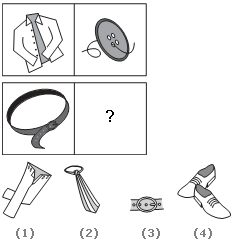Discussion
Home ‣ Logical Reasoning ‣ Statement and Conclusion See What Others Are Saying!
- Question
All flowers are toys. Some toys are trees. Some angels are trees Conclusions: 1. Some angels are toys 2. Some trees are flowers 3. Some flowers are angels
Options- A. None follows
- B. Only 1 follows
- C. Only 2 follows
- D. Only 1 and 3 follow
- Correct Answer
- None follows
ExplanationAll flowers are toys. Some toys are trees
Since the middle term 'toys' is not distributed even once in the premises,no definite conclusion follows.
Some toys are trees. Some angels are trees
Since both premises are particular,no definite conclusion an be drawn
- 1. Choose the picture that would go in the empty box so that the two bottom pictures are related in the same way as the top two:

Options- A. 1
- B. 2
- C. 3
- D. 4 Discuss
- 2. Which word does NOT belong with the others?
Options- A. couch
- B. rug
- C. table
- D. chair Discuss
- 3. Which word does NOT belong with the others?
Options- A. eel
- B. lobster
- C. crab
- D. shrimp Discuss
- 4. 14 14 26 26 38 38 50
Options- A. 60 72
- B. 50 62
- C. 50 72
- D. 62 62
- E. 62 80 Discuss
- 5. All guilty politicians were arrested. Kishan and Chander were among those arrested.
Options- A. All politicians are guilty.
- B. All arrested people are politicians.
- C. Kishan and Chander were not politicians.
- D. Kishan and Chander were guilty. Discuss
- 6. Statement: Is caste-based reservation policy in professional colleges justified?
Arguments:
- Yes. The step is a must to bring the underprivileged at par with the privileged ones.
- No. It obstructs the establishment of a classless society.
- Yes. This will help the backward castes and classes of people to come out of the oppression of upper caste people.
Options- A. Only I and II are strong
- B. Only II is strong
- C. Only II and III are strong
- D. Only I and III are strong
- E. All are strong Discuss
- 7. Statement: 'Guests should be provided lunch.' - A tells B.
Assumptions:
- Unless told, lunch may not be provided.
- Guests will stay during lunch time.
Options- A. Only assumption I is implicit
- B. Only assumption II is implicit
- C. Either I or II is implicit
- D. Neither I nor II is implicit
- E. Both I and II are implicit Discuss
- 8. Which word does NOT belong with the others?
Options- A. dodge
- B. flee
- C. duck
- D. avoid Discuss
- 9. Statement: Should agriculture in rural India be mechanized?
Arguments:
- Yes. It would lead to higher production.
- No. Many villagers would be left unemployed.
Options- A. Only argument I is strong
- B. Only argument II is strong
- C. Either I or II is strong
- D. Neither I nor II is strong
- E. Both I and II are strong Discuss
- 10. 28 25 5 21 18 5 14
Options- A. 11 5
- B. 10 7
- C. 11 8
- D. 5 10
- E. 10 5 Discuss
More questions
Correct Answer: 3
Explanation:
A shirt is to a button as a belt is to a belt buckle. A button is used to close a shirt; a belt buckle is used to close a belt.
Correct Answer: rug
Explanation:
The couch, table, and chair are pieces of furniture; the rug is not.
Correct Answer: eel
Explanation:
The lobster, crab, and shrimp are all types of crustaceans; an eel is a fish.
Correct Answer: 50 62
Explanation:
In this simple addition with repetition series, each number in the series repeats itself, and then increases by 12 to arrive at the next number.
Correct Answer: Kishan and Chander were guilty.
Correct Answer: Only II is strong
Explanation:
Clearly, capability is an essential criteria for a profession and reservation cannot ensure capable workers. So, neither I nor III holds strong. However, making one caste more privileged than the other through reservations would hinder the objectives of a classless society. So, argument II holds strong.
Correct Answer: Both I and II are implicit
Explanation:
Since both I and II follow from the statement, so both are implicit.
Correct Answer: flee
Explanation:
Dodge, duck, and avoid are all synonyms meaning evade. Flee means to run away from.
Correct Answer: Only argument I is strong
Explanation:
Clearly, mechanization would speed up the work and increase the production. So, argument I is strong enough. Argument II is vague because mechanization will only eliminate wasteful employment, not create unemployment.
Correct Answer: 11 5
Explanation:
This is an alternating subtraction series with the interpolation of a random number, 5, as every third number. In the subtraction series, 3 is subtracted, then 4, then 3, and so on.
Comments
There are no comments.More in Logical Reasoning:
Programming
Copyright ©CuriousTab. All rights reserved.
